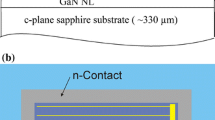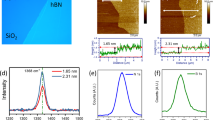Abstract
A novel vertical heteroepitaxial metal–oxide–semiconductor (MOS) device with extremely high minority carrier diffusion length has been characterized as a betavoltaic cell for power generation in harsh environment applications where solar photovoltaics cannot operate. The MOS structure has been realized by epitaxial growth of 40 nm thick yttrium oxide (Y2O3) layer through pulsed laser deposition on 20 μm thick n-type 4H-SiC epilayers with ultralow defect concentration. A 10 nm thick circular (10 mm2) nickel contact was deposited as the gate contact. The surface passivation effect of the Y2O3 layer and its large bandgap resulted in an extremely low leakage current density of 57 pA/cm2 at a reverse bias of − 250 V which is an order of magnitude less than that observed in benchmark Schottky barrier detectors at the same bias. The thin Y2O3 layer showed minimal absorption of 5486-keV alpha particles when exposed to a 241Am source and demonstrated a charge collection efficiency of 82%, measured in self-biased mode (0 V applied bias). When exposed to a 5 mCi 63Ni beta source, the MOS devices demonstrated an output power density of 11 nW/cm3 and a fill factor > 66% even with a partial illumination. The single pixel MOS devices discussed in this paper have shown a very high prospect to reach the maximum theoretical conversion efficiency of 25% predicted by the Klein relationship.







Similar content being viewed by others
Data availability
The datasets generated during and/or analyzed during the current study are available from the corresponding author on reasonable request.
Code availability
Not applicable.
References
S.I. Maximenko, J.E. Moore, C.A. Affouda, P.P. Jenkins, Optimal semiconductors for 3H and 63Ni betavoltaics. Sci. Rep. 9, 10892 (2019). https://doi.org/10.1038/s41598-019-47371-6
J. Dixon, A. Rajan, S. Bohlemann, D. Coso, A.D. Upadhyaya, A. Rohatagi, S. Chu, A. Majumdar, S. Yee, Evaluation of a silicon 90Sr betavoltaic power source. Sci. Rep. 6, 38182 (2016). https://doi.org/10.1038/srep38182
M. Li, J. Yang, Y. Shi, Z. Chen, P. Bai, H. Su, P. Xiong, M. Cheng, J. Zhao, Y. Xu, Soluble organic cathodes enable long cycle life, high rate, and wide-temperature lithium-ion batteries. Adv. Mater. 34(5), 2107226 (2021). https://doi.org/10.1002/adma.202107226
S.K. Chaudhuri, O. Karadavut, J.W. Kleppinger, R. Nag, G. Yang, D. Lee, K.C. Mandal, Enhanced hole transport in Ni/Y2O3/n-4H-SiC MOS for self-biased radiation detection. IEEE Electron Device Lett. 43(9), 1416–1419 (2022). https://doi.org/10.1109/LED.2022.3188543
J.W. Kleppinger, S.K. Chaudhuri, O. Karadavut, K.C. Mandal, Defect characterization and charge transport measurements in high-resolution Ni/n-4H SiC Schottky barrier radiation detectors fabricated on 250 μm epitaxial layers. J. Appl. Phys. 129, 244501 (2021). https://doi.org/10.1063/5.0049218
G. Lioliou, A.M. Barnett, Electron-hole pair creation and conversion efficiency in radioisotope microbatteries. Appl. Rad. Isotopes 180, 110042 (2021). https://doi.org/10.1016/j.apradiso.2021.110042
A. O’Connor, M.V. Manuel, S. Harry, An extended-temperature, volumetric source model for betavoltaic power generation. Trans. Am. Nucl. Soc. 121, 542–545 (2019)
M.G. Spencer, T. Alam, High power direct energy conversion by nuclear batteries. Appl. Phys. Rev. 6, 031305 (2019). https://doi.org/10.1063/1.5123163
G. Lioliou, A.B. Krysa, A.M. Barnett, Wide bandgap semiconductor conversion devices for radioisotope microbatteries. Mater. Sci. Semicond. Proc. 142, 106533 (2022). https://doi.org/10.1016/j.mssp.2022.106533
T. Shimaoka, H. Umezawa, K. Ichikawa, J. Pernot, S. Koizumi, Ultrahigh conversion efficiency of betavoltaic cell using diamond pn junction. Appl. Phys. Lett. 117, 103902 (2020). https://doi.org/10.1063/5.0020135
J.W. Murphy, L.F. Voss, C.D. Frye, Q. Shao, K. Kazkaz, M.A. Stoyer, R.A. Henderson, R.J. Nikolic, Design considerations for three-dimensional betavoltaics. AIP Adv. 9, 065208 (2019). https://doi.org/10.1063/1.5097775
K.C. Mandal, J.W. Kleppinger, S.K. Chaudhuri, Advances in high-resolution radiation detection using 4H-SiC epitaxial layer devices. Micromachines 11(3), 254 (2020). https://doi.org/10.3390/mi11030254
C.A. Klein, Bandgap dependence and related features of radiation ionization energies in semiconductors. J. Appl. Phys. 39, 2029–2038 (1968). https://doi.org/10.1063/1.1656484
S.K. Chaudhuri, K.C. Mandal, Radiation detection using n-type 4H-SiC epitaxial layer surface barrier detectors, in Advanced Materials for Radiation Detection. ed. by K. Iniewski (Springer, Berlin, 2021), pp.183–209
S.O. Kasap, M.Z. Kabir, K.O. Ramaswami, R.E. Johanson, R.J. Curry, Charge collection efficiency in the presence of non-uniform carrier drift mobilities and lifetimes in photoconductive detectors. J. Appl. Phys. 128, 124501 (2020). https://doi.org/10.1063/5.0017521
K. Ramaswami, R. Johanson, S. Kasap, Charge collection efficiency in photoconductive detectors under small to large signals. J. Appl. Phys. 125, 244503 (2019). https://doi.org/10.1063/1.5096900
H.J. Quah, W.F. Lim, S.C. Wimbush, Z. Lockman, K.Y. Cheong, Electrical properties of pulsed laser deposited Y2O3 gate oxide on 4H-SiC. Electrochem. Solid-State Lett. 13(11), H396–H398 (2010). https://doi.org/10.1149/1.3481926
H. Matsunami, T. Kimoto, Step-controlled epitaxial growth of SiC: high quality homoepitaxy. Mater. Sci. Eng. R Rep. 20(3), 125–166 (1997). https://doi.org/10.1016/S0927-796X(97)00005-3
J.J. Sumakeris, J.R. Jenny, A.R. Powell, Bulk crystal growth, epitaxy, and defect reduction in silicon carbide materials for microwave and power devices. MRS Bull. 30(4), 280–286 (2011). https://doi.org/10.1557/mrs2005.74
N. Piluso, A. Severino, R. Anzalone, M.A. Di Stefano, E. Fontana, M. Salanitri, S. Lorenti, A. Campione, P. Fiorenza, F. La Via, Growth of 4H-SiC epitaxial layer through optimization of buffer layer. Mater. Sci. Forum. 924, 84–87 (2018). https://doi.org/10.4028/www.scientific.net/MSF.924.84
W. Kern, The evolution of silicon wafer cleaning technology. J. Electrochem. Soc. 137(6), 1887–1892 (1990). https://doi.org/10.1149/1.2086825
I.C. Robin, R. Kumaran, S. Penson, S.E. Webster, T. Tiedje, A. Oleinik, Structure and photoluminescence of Nd:Y2O3 grown by molecular beam epitaxy. Opt. Mater. 30(6), 835–838 (2008). https://doi.org/10.1016/j.optmat.2007.03.003
S.M. Sze, K.K. Ng, Physics of Semiconductor Devices (Wiley, New Jersey, 2007)
R.T. Tung, The physics and chemistry of the Schottky barrier height. Appl. Phys. Rev. 1, 011304 (2014). https://doi.org/10.1063/1.4858400
A. LaPotin, K.L. Schulte, M.A. Steiner, K. Buznitsky, C.C. Kelsall, D.J. Friedman, E.J. Tervo, R.M. France, M.R. Young, A. Rohskopf, S. Verma, E.N. Wang, A. Henry, Thermophotovoltaic efficiency of 40%. Nature 604, 287–291 (2022). https://doi.org/10.1038/s41586-022-04473-y
M.B.H. Breese, A theory of ion beam induced charge collection. J. Appl. Phys. 74(6), 3789–3799 (1993). https://doi.org/10.1063/1.354471
J.F. Ziegler, M.D. Ziegler, J.P. Biersack, SRIM—the stopping and range of ions in matter. Nucl. Instrum. Meth. Phys. Res. B 268(11–12), 1818–1823 (2010). https://doi.org/10.1016/j.nimb.2010.02.091
C. Zhao, F. Liao, K. Liu, Y. Zhao, Breaking the myth: wide-bandgap semiconductors not always the best for betavoltaic batteries. Appl. Phys. Lett. 119, 153904 (2021). https://doi.org/10.1063/5.0068269
C. Zhao, L. Lei, F. Liao, D. Yuan, Y. Zhao, Efficiency prediction of planar betavoltaic batteries basing on precise modeling of semiconductor units. Appl. Phys. Lett. 117, 263901 (2020). https://doi.org/10.1063/5.0033052
V.S. Bormashov, S.Y. Troschiev, S.A. Tarelkin, A.P. Volkov, D.V. Teteruk, A.V. Golovano, M.S. Kuznetsov, N.V. Kornilov, S.A. Terentiev, V.D. Blank, High power density nuclear battery prototype based on diamond Schottky diodes. Diamond Relat. Mater. 84, 41–47 (2018). https://doi.org/10.1016/j.diamond.2018.03.006
Acknowledgements
The authors acknowledge partial financial support provided by the DOE Office of Nuclear Energy’s Nuclear Energy University Program (NEUP), Grant No. DE-NE0008662. The work was also supported in part by the Advanced Support Program for Innovative Research Excellence-II (ASPIRE-II), #155300-21-57381 and ASPIRE-I, Grant No. 15530-E404.
Funding
The authors acknowledge the partial financial support provided by the DOE Office of Nuclear Energy’s Nuclear Energy University Program (NEUP), Grant No. DE-NE0008662. The work was also supported in part by the Advanced Support Program for Innovative Research Excellence-II (ASPIRE-II), #155300-21-57381 and ASPIRE-I, Grant No. 15530-E404.
Author information
Authors and Affiliations
Contributions
All authors contributed to the study conception and design. Material preparation, data collection, and analysis were performed by [SKC], [RN], and [KCM]. The first draft of the manuscript was written by [SKC] and [KCM] and all authors commented on previous versions of the manuscript. All authors read and approved the final manuscript.
Corresponding author
Ethics declarations
Conflict of interest
The authors have no conflict of interest to declare that are relevant to the content of this article.
Ethical approval
Not applicable.
Consent to participate
Not applicable.
Consent for publication
Not applicable.
Additional information
Publisher's Note
Springer Nature remains neutral with regard to jurisdictional claims in published maps and institutional affiliations.
Rights and permissions
Springer Nature or its licensor (e.g. a society or other partner) holds exclusive rights to this article under a publishing agreement with the author(s) or other rightsholder(s); author self-archiving of the accepted manuscript version of this article is solely governed by the terms of such publishing agreement and applicable law.
About this article
Cite this article
Chaudhuri, S.K., Nag, R. & Mandal, K.C. A novel Ni/Y2O3/4H-SiC heteroepitaxial metal–oxide–semiconductor (MOS) betavoltaic cell. J Mater Sci: Mater Electron 34, 543 (2023). https://doi.org/10.1007/s10854-023-09971-x
Received:
Accepted:
Published:
DOI: https://doi.org/10.1007/s10854-023-09971-x




